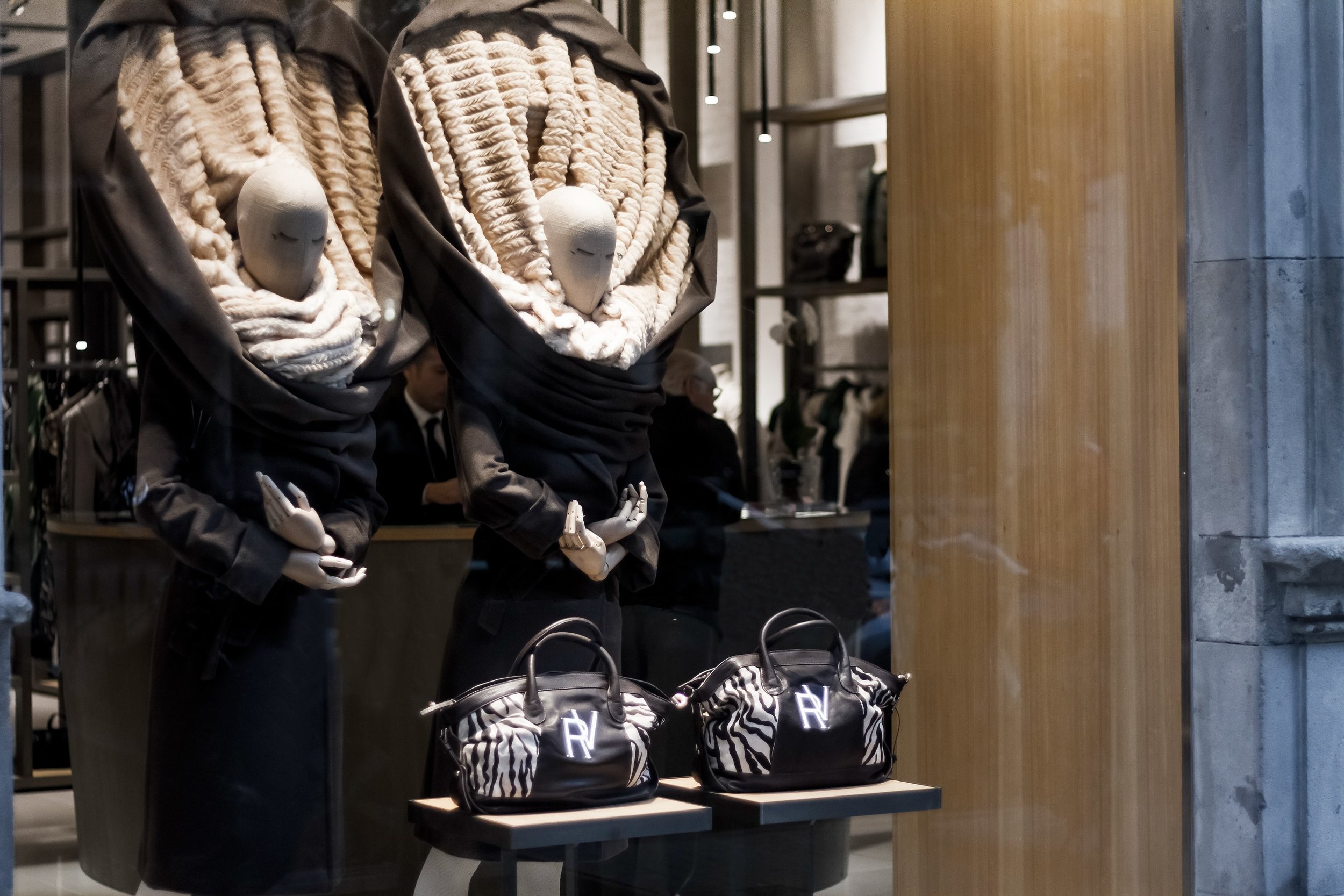7 Aesthetic Qualities Proving Visual Merchandising is Art
Guest blog post by Juan Carlos Barrón
Visual Design in the display of ROBERTO VERINO by Juan Carlos Barrón
Store windows have changed since the days they were thoughts of as mere product shelving. Today, the front window is heavily regarded as the soul of the store, the first impression that draws shoppers in. But that is not where the work ends. Once inside, the store itself should exude a specific artistic presence known as visual merchandising.
Like Picasso’s paintbrush, merchandising is not only visual art, but emotional art – making the shopping experience memorable.
Like any other medium, this ephemeral art form possesses certain attributes that define yet differentiate it from other creative expressions. But as consumer tastes evolve and become more demanding, merchandisers must continually reevaluate the role of contemporary visual merchandising strategies.
One way to do this is to understand the foundation of visual merchandising – from the principles of visual research to the subsequent analysis of the results, in regards to both the brand image level and product sales.
1. Talent
The chief aim of a visual merchandiser is to maximize sales by communicating with the target audience and creating a positive atmosphere. But as personal experiences mold artistic expression, the presentation of VM is intrinsically linked to its creator – a reflection and expression of their personality.
There is a plethora of skills required in VM that can be learned – organisation and self-management, communication and interpersonal skills – however, the innovative and creative aspects come to those with an inner gift. While the ability to execute design is more academic, the intelligence needed to conceptualise these visual creations is not something easily taught.
2. Concept
There are four major visual merchandising messages: critical, reflective, testimonial, and exaltation. Within these messages lie manifest, codified, or intellectual concepts.
When you dive deeper into these concepts, personal themes may emerge that express feelings, ideals, motivations and experiences. Likewise, environmental themes including political, religious or philosophical ideologies of individual creative directors may also exist within their creations.
Most brands, however, tend to shy away from statement-making displays. Visual merchandisers have the responsibility to express the principles and values of the client.
That said, it’s nearly impossible to erase the complete individual identity of the artist. And sometimes, when you commission a more famous artist (perhaps with a more famous temper), you must understand that by employing their name and reputation, you may bite off more than you can chew.
Take the relationship between Salvador Dalí and Bonwit-Teller in New York.
Unbeknownst to him, after creating two window displays for the Manhattan location, Dalí’s creations were changed by store employees. Upon his arrival back to the store, in a fit of artistic integrity, the artist crashed through the store window.
Diego Rivera mural on Rockefeller Plaza, 1993. Inspired by Marxist ideology, the commissioned work was destroyed shortly after unveiling.
3. Medium
In its format, both the store’s exterior and interior showcase a storyline. This visual storytelling is similar to that of an artist’s rendering – with regards to composition, proportion and lighting.
However, artistic techniques and disciplines are only the means expression, not the art itself. Consider the differences between photographic and digital art.
Photographs considered a work of art have an artistic realization, not that of commercial aspect. On the other hand, digital art – websites, illustrations, advertising, Social Media etc. – may not have a direct artistic quality, rather it’s designed in such a way that it has an artistic meaning defined by its creator.
Contemporary visual merchandising and window dressing work much the same way where the focus is on the presentation of merchandise.
4. Context
Visual merchandising sets the context of merchandise in an aesthetically pleasing fashion, presenting them in a way that converts shoppers into buyers.
As a contemporary arts discipline, artistic displays often reflect a particular situation – place and time – in which the merchandiser so chooses.
As it’s manifested in the concept of the work, the context can be of personal influence or of the artist's environment. It should be noted that the reflection of the sociocultural context in the work also makes it a valuable testimony of time and cultural identity of a geography.
Ernst Ludwig Kirchner, Self-Portrait as a Soldier (1915) reflect the feeling of political instability during the expressionist period.
Jewelry designer, Alexis Bittar, gets political in his Trump-themed “Salute to Absurdity” display.
5. Style
The work of visual art of the last century is influenced by the artistic styles that have defined certain aesthetic, conceptual or ideological characteristics shared and assimilated in certain eras.
The styles arise first in a specific locations by one or several artists with a particular degree of influence. It is then exported to other areas where they may undergo a certain transformation to fit within those confines.
Abstract Window Art on a Freelance Basis by Juan Carlos Barrón
Some styles evolve, however this is not always the case – multiple trends developing in the same century are not always a continuation of previous ideas. Even still, former practices may be taken up centuries later with a fresh perspective. For instance, the Renaissance era was inspired by Grecian and Roman classical period. It also found a revival in neoclassical art and again in the twentieth century with neomodernism.
These trends are no more different than what you see in visual art and even merchandising.
Dominant styles are presently conceptual-abstract art, however, visual art breaks with the established so that other styles and artists can emerge.
This is why even though merchandisers stay up-to-date on the latest fashion trends, they still must understand the value and history of the brand they represent and the customers targeted to buy. After all, as consumer increasingly demand more personalised products and experiences, it is up to the VM team to create a sense of loyalty with a brand. They do this through taking a trend and making it their own – crafting a style – and embodying a specific personality.
6. Value
Though dependent upon a viewer’s perspective, visual art, regardless the medium, has a purpose and value. A piece displayed in MOMA is not the same as a shop window – no matter how cool the latter may be.
Artworks acquire value for their proposal or innovation.
Transcribing styles of a particular era, expressing the ideals and idiosyncrasies of a place, time or brand, and the ability to approach certain themes are skills required of visual merchandisers and artists alike.
Furthermore, because retailers are dependent upon visual merchandising in order to maximise sales, that, in itself, is the highest value.
7. Aesthetics
Art is not synonymous with beauty or aesthetics, although it is an intrinsic quality present in most. Aesthetics is completely subjective and there is no parameter to define it. From the viewer’s preference, personal conception, and culture context all form aesthetic perceptions.
The globalisation of visual merchandising – both in the context of stores and e-commerce – are imposing the same visual tastes across the planet. As Andy Warhol once said:
“Someday, all department stores will become museums and all museums will become department stores.”
That day has arrived.
Visual merchandisers who create a complete visual strategy are artists in their field and their creations – from window dressing to online stores to merchandising – this is already an art.
About Juan Carlos Barrón
Juan Carlos Barrón’s is a Visual Merchandiser & Creative Project Manager by heart. His ability to translate a brand’s identity into appealing and original visuals enabled him to work with great companies like Zara and Lladró, The Conran Shop, Value Retail, National Geographic Stores, Galeries Lafayette, Viktor & Rolf, LÓréal Luxe, Hermès and Armani. He got a Master Degree in Visual Merchandising & Space Management and took several courses to enhance his knowledge in graphic design with programmes like InDesign, Illustrator, Photoshop, Live Interior 3D, Mockshop and Shopshape. His work had a huge impact on strengthening the importance of brand presentation at POS by enhancing Store Implementation, Retail Marketing and Visual Merchandising activities. He also taught at Istituto Europe di Design in the Master’s Programme "Window Display & Visual Merchandising". Right now he is building his own Window Design Company Barron Visual Studio and working together with Agent Provocateur, Pablo and Chanel.
You can find more impressions of this work on his portfolio or on his company’s Facebook page.

 Français
Français





